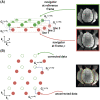Model-based dynamic off-resonance correction for improved accelerated fMRI in awake behaving nonhuman primates
- PMID: 35081259
- PMCID: PMC9306555
- DOI: 10.1002/mrm.29167
Model-based dynamic off-resonance correction for improved accelerated fMRI in awake behaving nonhuman primates
Abstract
Purpose: To estimate dynamic off-resonance due to vigorous body motion in accelerated fMRI of awake behaving nonhuman primates (NHPs) using the echo-planar imaging reference navigator, in order to attenuate the effects of time-varying off-resonance on the reconstruction.
Methods: In NHP fMRI, the animal's head is usually head-posted, and the dynamic off-resonance is mainly caused by motion in body parts that are distant from the brain and have low spatial frequency. Hence, off-resonance at each frame can be approximated as a spatially linear perturbation of the off-resonance at a reference frame, and is manifested as a relative linear shift in k-space. Using GRAPPA operators, we estimated these shifts by comparing the navigator at each time frame with that at the reference frame. Estimated shifts were then used to correct the data at each frame. The proposed method was evaluated in phantom scans, simulations, and in vivo data.
Results: The proposed method is shown to successfully estimate spatially low-order dynamic off-resonance perturbations, including induced linear off-resonance perturbations in phantoms, and is able to correct retrospectively corrupted data in simulations. Finally, it is shown to reduce ghosting artifacts and geometric distortions by up to 20% in simultaneous multislice in vivo acquisitions in awake-behaving NHPs.
Conclusion: A method is proposed that does not need sequence modification or extra acquisitions and makes accelerated awake behaving NHP imaging more robust and reliable, reducing the gap between what is possible with NHP protocols and state-of-the-art human imaging.
Keywords: EPI; dynamic off-resonance; fMRI; nonhuman primates; simultaneous multislice.
© 2022 The Authors. Magnetic Resonance in Medicine published by Wiley Periodicals LLC on behalf of International Society for Magnetic Resonance in Medicine.
Figures





References
-
- Orban GA. Functional MRI in the awake monkey: the missing link. J Cogn Neurosci. 2002;14:965‐969. - PubMed
Publication types
MeSH terms
Grants and funding
LinkOut - more resources
Full Text Sources
Medical
Miscellaneous

